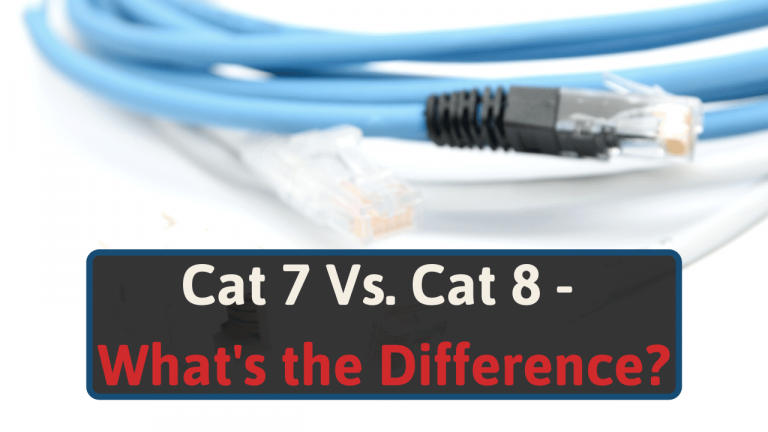As a network enthusiast, I will explain to you the difference between Cat 7 and Cat 8 Ethernet cables.
This includes going over what they are, their pros and cons, and how to tell them apart.
Let’s jump right into it.
The Differences Between Cat 7 vs. Cat 8 Ethernet Cables
Cat 7 and Cat 8 Ethernet cables are two of the latest generations, with Cat 8 being the newest. Although they share a few similarities, there are several clear advancements from the older version to the newer generation.
| Criteria | Cat 7 | Cat 8 |
| Frequency | 600MHz | 2,000MHz |
| Max Speed | 40 Gbps at 10 meters | 25 Gbps at 100 meters and 40 Gbps at 30 meters |
| Crosstalk | Twisted cables help eliminate crosstalk | Similar to Cat 7 |
| Lifespan | 15 years | 15 years |
| TIA/EIA Recognition (More on this later) | No | Yes |
| Power over Ethernet | No | Yes |
| Average Cost | $0.60 per foot | $0.70 per foot |
What is Cat 7?
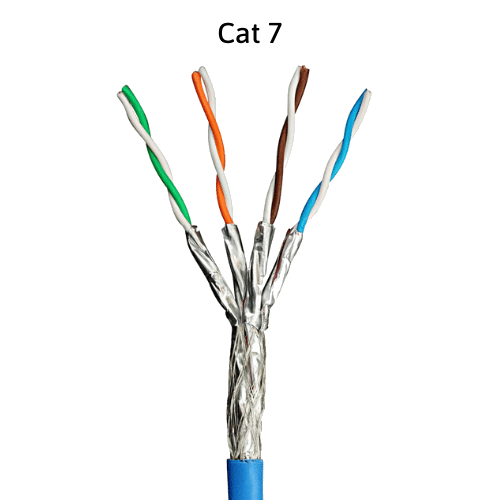
Category 7 cable, also referred to as Cat 7 or Cat-7 cable, is a type of cable used for the infrastructure of Gigabit Ethernet.
It’s the seventh generation of Ethernet cables and a strong choice for office buildings and data centers. It offers high-speed ethernet communication of up to 40 Gbps at 10 meters (32.8 feet) distances.
Generally, Cat 7 cables have shielding for optimal noise resistance and attaining high frequency.
These cables work at 600MHz, which is considerably higher than the 250MHz or Cat 6 cables. This allows the cable to attain download speeds of up to 40 Gbps of data transfer.
As you can see, Cat 7 has strong data transfer rates, even at extended distances. As such, it is a solid option for LAN connections in office environments.
Cat 7 Pros and Cons
Category 7 cables offer several advantages and disadvantages. A few of these include:
Pros
- Superior transfer rates compared to previous generation cables
- Better noise resistance from shielding (low crosstalk)
- Higher operating frequency than previous generations
- Backward compatibility
Cons
- Pricier than previous generations
- Operates similar to Cat 6a system
- No TIA/EIA recognition
What is Cat 8?
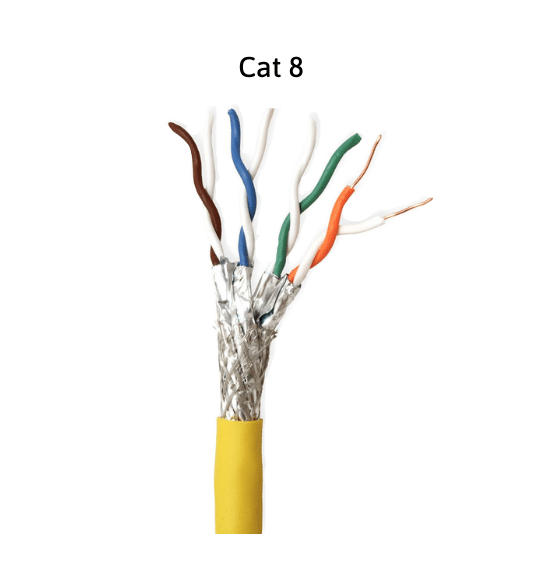
Cat 8, or Category 8 cable, is the most recent Ethernet cable standard. It is currently the best, most modern option available.
The Cat 8 cables are new and improved compared to Cat 7. They use a two connector channel and a frequency of up to 2,000MHz, which is considerably faster than all previous generations.
The distance range increased from Cat 7 to Cat 8. Cat 8 supports distances of up to 30m at 40 Gbps transfer speeds, compared to 10m for Cat 7.
Cat 8 cables have protective shielding for better quality transmission in terms of design and construction. Its overall appearance isn’t majorly different from previous generations, and it can terminate in RJ45 or non-RJ45 connections.
Cat 8 cables are also backward compatible. So there shouldn’t be any issues using it with previous generations.
Cat 8 Pros and Cons
The newest Ethernet cable, Cat 8, presents its fair share of pros and cons. A few of the highs and lows of Cat 8 include:
Pros
- Speeds up to 40Gbps at 30 meters and 25 Gbps at 100 meters
- Backward compatible with previous generations
- Power over Ethernet (PoE) capability
- Higher frequencies than Cat 7
Cons
- Not intended for long-distance connections
- Pricier than the previous version
- Much of its performance isn’t utilized by a home network
Cat 7 Vs. Cat 8
Cat 7 and Cat 8 share some similarities, but several differences set them apart. In the following sections, we take a quick look at the two, head to head, in several categories.
Cost
Cat 7 network cable tends to be less expensive than Cat 8. The added price isn’t a surprise. Mostly because Cat 8 cables have unique features different from previous Ethernet cables. Both new generations are considerably more expensive than previous versions, including:
- Cat 5e
- Cat 6
- Cat 6a
Connection Type
Cat 7 cables have four twisted pairs of wires. The specific connection type in Cat 7 cables is often the GG45 (non-RJ-45) connector.
On the flip side, it’s easy to find Cat 8 cables with GG45 or RJ-45 connectors. Class I Cat 8 cables use RJ45 connectors, while Class II uses non-RJ-45 connectors.
Regardless of which Cat 8 cable you use, it is backward compatible with previous devices. So you can use it without an issue.
Speed
Cat 8 cables have faster max download speeds than Cat 7 cables.
Cat 8 cables are capable of speeds up to 40 Gbps for around 30 meters. While Cat 7 cables max out at 40 Gbps for around 10 meters.
Frequency
In terms of frequency, there’s a clear winner. Cat 8 cables operate at a much higher frequency of 2GHZ or 2,000MHz. Compared to Cat 7 cables, which run at 600MHz.
It makes sense that Cat 8 has a higher frequency since it’s necessary for faster data transfer speeds.
Crosstalk
Both cables eliminate crosstalk reasonably well. Crosstalk is interference from other wires that slow data transfer.
Cat 7 and Cat 8 cables have all twisted cable pairs shielded within the main jacket. This shielding supports a more stable overall connection. And it assists in eliminating all forms of crosstalk.
On average, their shielding provides up to 15 dB in alien crosstalk reduction.
TIA/EIA Recognition
Cat 8 cables have Telecommunications Industry Association (TIA) and the Electronic Industries Alliance (EIA) recognition. Cat 7 cables don’t meet these standards.
But, it doesn’t mean Cat 7 cables are “bad.” It just means the cable doesn’t meet standards that data centers and large networks follow. This means TIA/EIA recognition doesn’t apply to your home network.
How to Visually Tell Cat 7 and Cat 8 Cables Apart
Cat 7 and Cat 8 (Class II) cables don’t look drastically different, making telling them apart tricky. What you will notice is that Cat 8 is a bit thicker and if you would look inside you would see some extra shielding.
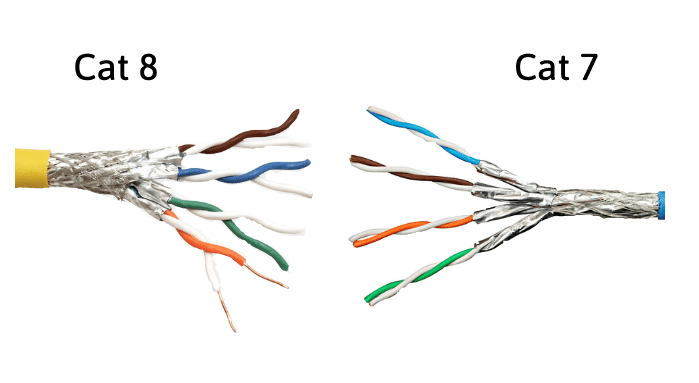
Generally, Ethernet cables have their specifications printed along the sheath. It may say “category” or “cat,” followed by a number. Look for this text on the sheath. It will tell you what cable you have.
Are There Other CAT Options?
Yes, there are alternatives to Cat 7 and Cat 8 cables. One option is Cat 5e cables. They can support speeds up to 10Mbps, 100 Mbps, or 1000 Mbps.
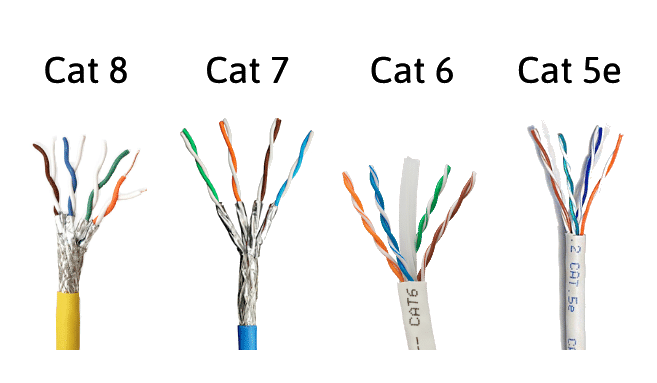
Cat 5e distance limit is 100 meters. It can perform at up to 100MHz.
Another option is Cat 6. It offers a maximum transmission speed of 1 Gbps at 100m. Plus, it can transmit signals at 250 MHz. Cat 6a operates at up to 500MHz and has a max speed of 10 Gbps.
Yet, the advancements from Cat 5e and Cat 6 to Cat 7 and Cat 8 are evident. Check out our guide on Cat 5e and Cat 6 for more information on these Cat options.
Can I Upgrade from a Cat 7 to a Cat 8?
Yes. If you use a Cat 8 Class II cable, you can upgrade from Cat 7 to Cat 8. Since Cat 8 cables are backward compatible with previous versions. So you shouldn’t have any issues upgrading.
Which is Best for You, Cat 7 or Cat 8?
Cat 8 cables are better than Cat 7 cables. But for home networks, Cat 7 cables will be more than enough. Thus, we at Networks Hardware recommend you get Cat 7 or Cat 6 cables for your home network.
That said, If you’re operating a data center, Cat 8 (Class II) might be the right choice for you. It has GG45 connectors that work with commercial networking equipment.
Click here for more information about Ethernet and how it works.
Conclusion
Ultimately, the best cable category falls to you and your particular preferences.
Cat 8 cables offer multiple advancements from Cat 7 cables, yet many individuals won’t even use the full performance capability in a home network setting. In addition, Cat 8 cables tend to be pretty pricey.
However, you should pick the option that aligns best with your personal needs, as everyone’s priorities and needs are different. Cat 7 and Cat 8 cables both offer strong performance and should easily see to your needs.
To learn about how Cat 7 compares to Cat 6 cables, check out our guide here.

